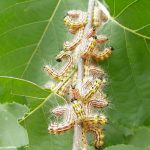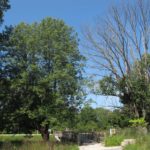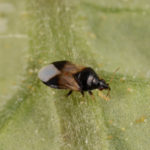Several caterpillar pests feed on trees and shrubs in July. Although most trees can tolerate some defoliation, the injury can be unsightly for much of the summer. Damage to plants can be reduced by timely applications of insecticides. Proper choice of insecticides can reduce impacts on pollinators and natural enemies of spider mites that do[Read More…]
Resources for landscapes and gardens in the Midwest
Entomology
Late frosts and wet weather were especially hard on oaks this spring. Surviving leaves on many oaks did not grow normally. Sustained warm weather in the summer will allow oaks to grow past their injury and thrive. Oak tatters is a common response to cold snaps in the late spring. Leaf growth is distorted. Affected[Read More…]
Trees and shrubs can lose their leaves for many reasons. The maple tree in the cover photo is planted in a parking lot, and mulched incorrectly. The parking lot location gives the tree much less access to rainwater than a tree planted in a park-like pavement free location. Deep mulch piled like a volcano aggravates[Read More…]
Jumping worms (a.k.a. snake worms, crazy worms, Amynthas spp.) While you’re gardening in the coming weeks keep your eyes peeled for jumping, wriggling worms. Asian jumping worms are spreading in the Midwest and they can do serious damage to your yard. Where are they from? No one is sure exactly how jumping worms were[Read More…]
Earthworms are not the only wigglers in the soil beneath your feet. Nematodes, microscopic roundworms, can be found in soil across the globe (even Antarctica!) and are often a barometer of soil and environmental health. However, the nematodes we encounter more frequently feed on plants and cause us, as plant stock producers and consumers, a[Read More…]
Join us May 12th at 4:00 pm (EDT) at this link: https://purdueextension.zoom.us/j/92562247848 The Purdue Green Industry Team and Indiana Nursery and Landscape Association would like to invite you to a virtual event for the Green Industry and other Agri-Businesses featuring United States Senator Mike Braun. He will be providing updates for Agri-Businesses from the federal[Read More…]
Labor issues and timing of tree care activities have been and will continue to be impacted by federal and state rulings as a result of CoVid-19. As a result of social distancing and confusion surrounding “essential services”, many plant health care technicians and business operations have been suspended. As the season progresses, these labor suspensions[Read More…]
When houseplants and garden seedlings are kept too wet, roots can rot and the fungus that grows in the soil can feed fungus gnats. For houseplants, fungus gnats are usually just a nuisance. When growing seedlings or in a greenhouse adults can spread fungal diseases to flowers. Larvae can spread fungal diseases when they feed[Read More…]
The 2019 season provided challenges that were unexpected to the Green Industry, which included an abundance of rainfall followed by drought-like conditions, new invasive pests, concerns about glyphosate use, and many others. The Purdue Landscape Report focuses on timely articles that help Green Industry professionals make decisions for their business and keep abreast of looming[Read More…]
This year has been a rollercoaster of good (e.g. continued progress on the long term fight against emerald ash borer) and bad (e.g. sudden oak death potentially being introduced into the Midwest) news about invasive species. There’s been a lot to keep track of, but don’t worry if you’ve missed anything. You can learn all[Read More…]
Don’t miss the 2019 Purdue Turf and Landscape Field Day on July 9th! Your opportunity to interact with Purdue Specialists, see the latest on-going research and best management practices, and network with others in the Green Industry. This is the premiere Green Industry education event that you’ll find this summer! https://www.mrtf.org/event/turf-and-landscape-field-day/?event_date=2019-07-09 In the landscape track,[Read More…]
Sign-up to receive email news and alerts from Purdue Landscape Working Group:



















